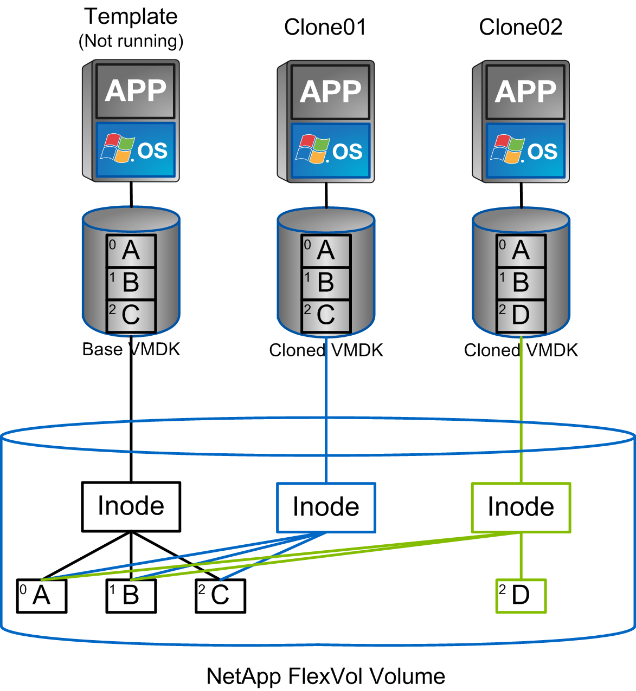VM and datastore cloning
 Suggest changes
Suggest changes


Cloning a storage object allows you to quickly create copies for further use, such as provisioning additional VMs, backup/recovery operations, and so on.
In vSphere, you can clone a VM, virtual disk, vVol, or datastore. After being cloned, the object can be further customized, often through an automated process. vSphere supports both full copy clones, as well as linked clones, where it tracks changes separately from the original object.
Linked clones are great for saving space, but they increase the amount of I/O that vSphere handles for the VM, affecting performance of that VM and perhaps the host overall. That's why NetApp customers often use storage system-based clones to get the best of both worlds: efficient use of storage and increased performance.
The following figure depicts ONTAP cloning.

Cloning can be offloaded to systems running ONTAP through several mechanisms, typically at the VM, vVol, or datastore level. These include the following:
-
vVols using the NetApp vSphere APIs for Storage Awareness (VASA) Provider. ONTAP clones are used to support vVol snapshots managed by vCenter that are space-efficient with minimal I/O effect to create and delete them. VMs can also be cloned using vCenter, and these are also offloaded to ONTAP, whether within a single datastore/volume or between datastores/volumes.
-
vSphere cloning and migration using vSphere APIs – Array Integration (VAAI). VM cloning operations can be offloaded to ONTAP in both SAN and NAS environments (NetApp supplies an ESXi plug-in to enable VAAI for NFS). vSphere only offloads operations on cold (powered off) VMs in a NAS datastore, whereas operations on hot VMs (cloning and storage vMotion) are also offloaded for SAN. ONTAP uses the most efficient approach based on source and destination. This capability is also used by Omnissa Horizon View.
-
SRA (used with VMware Live Site Recovery/Site Recovery Manager). Here, clones are used to test recovery of the DR replica nondisruptively.
-
Backup and recovery using NetApp tools such as SnapCenter. VM clones are used to verify backup operations as well as to mount a VM backup so that individual files can be restored.
ONTAP offloaded cloning can be invoked by VMware, NetApp, and third-party tools. Clones that are offloaded to ONTAP have several advantages. They are space-efficient in most cases, needing storage only for changes to the object; there is no additional performance effect to read and write them, and in some cases performance is improved by sharing blocks in high-speed caches. They also offload CPU cycles and network I/O from the ESXi server. Copy offload within a traditional datastore using a FlexVol volume can be fast and efficient with FlexClone licensed (included in the ONTAP One license), but copies between FlexVol volumes might be slower. If you maintain VM templates as a source of clones, consider placing them within the datastore volume (use folders or content libraries to organize them) for fast, space efficient clones.
You can also clone a volume or LUN directly within ONTAP to clone a datastore. With NFS datastores, FlexClone technology can clone an entire volume, and the clone can be exported from ONTAP and mounted by ESXi as another datastore. For VMFS datastores, ONTAP can clone a LUN within a volume or a whole volume, including one or more LUNs within it. A LUN containing a VMFS must be mapped to an ESXi initiator group (igroup) and then resignatured by ESXi to be mounted and used as a regular datastore. For some temporary use cases, a cloned VMFS can be mounted without resignaturing. After a datastore is cloned, VMs inside it can be registered, reconfigured, and customized as if they were individually cloned VMs.
In some cases, additional licensed features can be used to enhance cloning, such as SnapRestore for backup or FlexClone. These licenses are often included in license bundles at no additional cost. A FlexClone license is required for vVol cloning operations as well as to support managed snapshots of a vVol (which are offloaded from the hypervisor to ONTAP). A FlexClone license can also improve certain VAAI-based clones when used within a datastore/volume (creates instant, space-efficient copies instead of block copies). It is also used by the SRA when testing recovery of a DR replica, and SnapCenter for clone operations and to browse backup copies to restore individual files.


